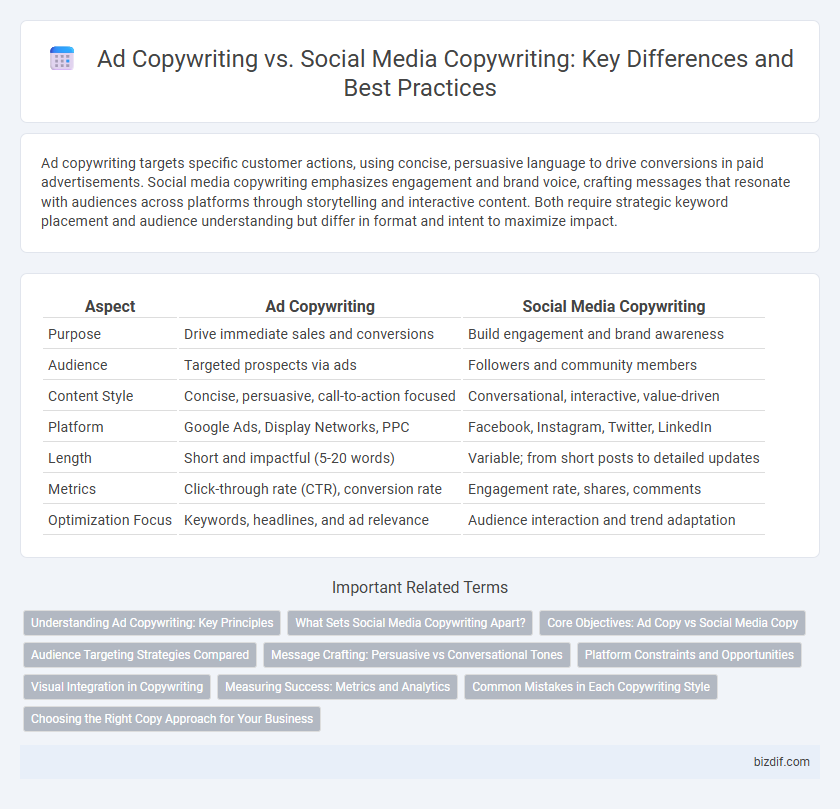Ad copywriting targets specific customer actions, using concise, persuasive language to drive conversions in paid advertisements. Social media copywriting emphasizes engagement and brand voice, crafting messages that resonate with audiences across platforms through storytelling and interactive content. Both require strategic keyword placement and audience understanding but differ in format and intent to maximize impact.
Table of Comparison
| Aspect | Ad Copywriting | Social Media Copywriting |
|---|---|---|
| Purpose | Drive immediate sales and conversions | Build engagement and brand awareness |
| Audience | Targeted prospects via ads | Followers and community members |
| Content Style | Concise, persuasive, call-to-action focused | Conversational, interactive, value-driven |
| Platform | Google Ads, Display Networks, PPC | Facebook, Instagram, Twitter, LinkedIn |
| Length | Short and impactful (5-20 words) | Variable; from short posts to detailed updates |
| Metrics | Click-through rate (CTR), conversion rate | Engagement rate, shares, comments |
| Optimization Focus | Keywords, headlines, and ad relevance | Audience interaction and trend adaptation |
Understanding Ad Copywriting: Key Principles
Ad copywriting centers on crafting concise, persuasive messages designed to drive immediate action, such as clicks or purchases. Key principles include clarity, emotional appeal, and a strong call-to-action that resonates with the target audience's needs and pain points. Mastering these elements ensures ad copy delivers high conversion rates and measurable ROI.
What Sets Social Media Copywriting Apart?
Social media copywriting is tailored for engagement and rapid interaction, often using concise, relatable language that resonates with diverse audiences across platforms like Facebook, Instagram, and Twitter. It leverages visual elements, hashtags, and trending topics to boost visibility and foster community participation, distinguishing it from traditional ad copywriting's focus on direct sales and longer-form persuasive content. The dynamic, conversational tone and real-time adaptability in social media copywriting prioritize building brand personality and fostering ongoing dialogue with users.
Core Objectives: Ad Copy vs Social Media Copy
Ad copywriting prioritizes direct response by crafting compelling headlines and persuasive calls-to-action designed to drive immediate conversions and sales. Social media copywriting focuses on engagement and brand awareness, utilizing conversational tone and shareable content to foster community interaction and long-term loyalty. Understanding these core objectives helps marketers tailor messages that maximize ROI across different platforms.
Audience Targeting Strategies Compared
Ad copywriting utilizes direct, concise messaging tailored to specific buyer personas, leveraging psychographic and demographic data for high-conversion campaigns. Social media copywriting adopts a more conversational tone, emphasizing engagement and community-building by targeting audiences through platform-specific algorithms and behavioral insights. Both strategies require precision in audience segmentation but differ in tone and interaction frequency to optimize reach and conversion rates.
Message Crafting: Persuasive vs Conversational Tones
Ad copywriting emphasizes persuasive tones designed to drive immediate action through compelling calls-to-action and clear value propositions, optimizing conversion rates. Social media copywriting prioritizes conversational tones that foster engagement, build brand personality, and encourage community interaction through relatable language and storytelling. Both strategies require tailored message crafting to align with audience behavior and platform objectives for maximum impact.
Platform Constraints and Opportunities
Ad copywriting thrives within concise character limits and clear call-to-actions, optimizing ad platforms like Google Ads or Facebook Ads for immediate engagement and conversions. Social media copywriting leverages platform-specific features such as hashtags on Instagram, trending topics on Twitter, or Stories on Snapchat, enabling interactive and shareable content tailored to audience behavior. Understanding platform constraints and opportunities enhances message effectiveness by aligning tone, length, and format with user expectations and engagement patterns.
Visual Integration in Copywriting
Ad copywriting emphasizes concise, persuasive language that drives action, often paired with strong visual elements like bold headlines and compelling images to capture immediate attention. Social media copywriting integrates visuals more fluidly, using a blend of short text, emojis, hashtags, and interactive graphics to enhance engagement and shareability. Effective visual integration in both types boosts message retention and brand recall by aligning imagery with targeted copy for maximum emotional impact.
Measuring Success: Metrics and Analytics
Measuring success in ad copywriting hinges on conversion rates, click-through rates (CTR), and return on ad spend (ROAS), which directly reflect the ad's effectiveness in driving sales. Social media copywriting success metrics emphasize engagement rates, follower growth, and sentiment analysis, highlighting audience interaction and brand perception. Analyzing these distinct KPIs through tools like Google Analytics and social media insights platforms enables data-driven optimization tailored to each copywriting format.
Common Mistakes in Each Copywriting Style
Ad copywriting often suffers from overly generic headlines and lack of a clear call-to-action, which reduces conversion rates significantly. Social media copywriting frequently falls into the trap of inconsistent brand voice and excessive hashtag use, leading to diminished engagement and audience trust. Both styles require precision in targeting audience intent and clarity to avoid common pitfalls that undermine campaign effectiveness.
Choosing the Right Copy Approach for Your Business
Ad copywriting focuses on crafting persuasive messages aimed at driving immediate sales through clear calls-to-action in ads, while social media copywriting emphasizes engagement and brand voice tailored for platforms like Facebook, Instagram, and Twitter. Selecting the right copy approach depends on your business goals: choose ad copywriting to boost conversions and direct response campaigns, or social media copywriting to build community and foster ongoing customer relationships. Understanding your target audience's behavior and the marketing channel's strengths ensures optimized content that enhances brand visibility and drives measurable results.
Ad Copywriting vs Social Media Copywriting Infographic

 bizdif.com
bizdif.com